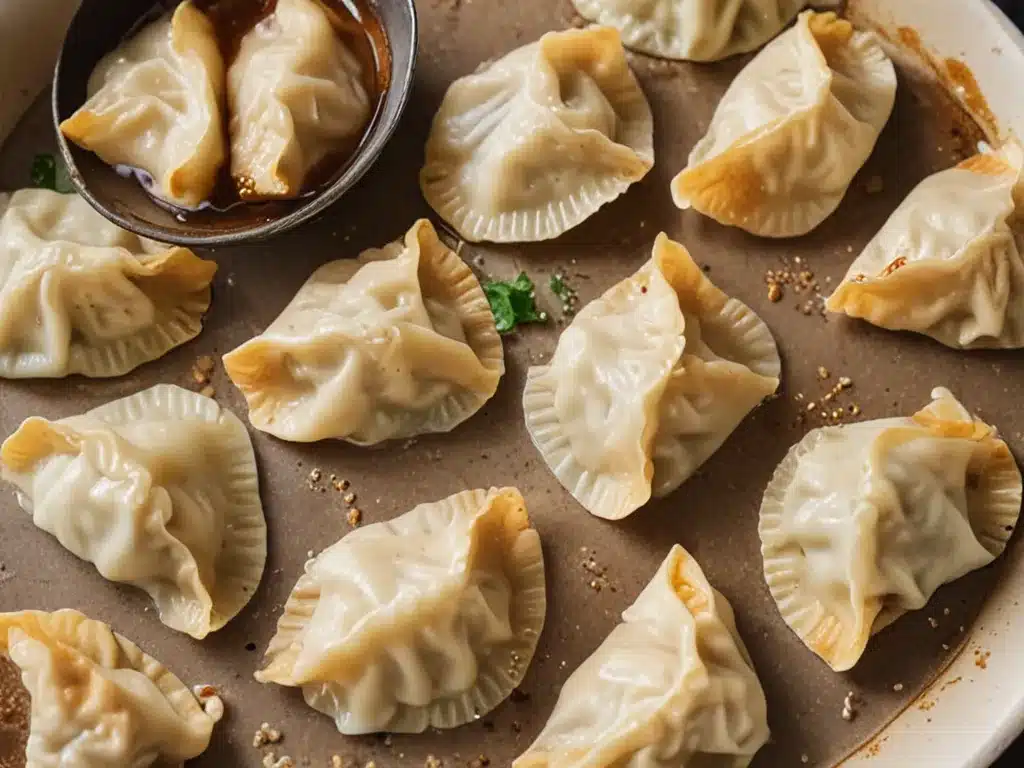
Boiling the filling ingredients
As I was planning to make homemade potstickers using store-bought wrappers, the first step was to prepare the filling. For the filling, I decided to use a combination of ground pork, Napa cabbage, grated carrots, garlic, ginger, soy sauce, and sesame oil.
I started by cutting the Napa cabbage into thin strips. Then, I boiled the cabbage strips for about 2 minutes to soften them. I drained and cooled the boiled cabbage. Next, I minced the garlic and grated the carrots. I heated sesame oil in a pan and stir fried the ground pork until it was fully cooked. I then added the minced garlic and grated ginger and cooked for another minute, stirring frequently.
Lastly, I added the boiled and drained Napa cabbage, grated carrots, and soy sauce to the cooked ground pork. I mixed everything together thoroughly until the filling had a moist but not wet texture. I allowed the filling to cool completely before using it to wrap the store-bought wrappers.
Wrapping the potstickers
Once the filling was fully cooled, I started wrapping the potstickers. I laid out the circular store-bought wrappers and placed about one tablespoon of the cooled filling in the center of each wrapper.
I wet the edges of the wrapper with water using my finger. I then brought one side of the wrapper over the filling and pressed to seal it, squeezing out any air and excess moisture. Next, I pleated the sealed edge tightly to create a nice crimped look.
I placed the shaped potstickers on a lightly floured baking sheet as I wrapped them to prevent sticking. Wrapping the potstickers requires a bit of practice to get the folds and crimps looking neat and uniform. But with some trial and error, the technique becomes quite easy.
Pan frying the potstickers
Once all the potstickers were shaped, I started pan frying them in batches. I heated sesame oil in a non-stick pan over medium-high heat. I then placed the potstickers crimped-side down in the hot oil, without overcrowding the pan.
I let the potstickers cook undisturbed for 3-4 minutes, until the bottoms were deep golden brown. During this time, I adjusted the heat as needed to prevent burning. Once browned, I added about 2-3 tablespoons of water to the pan. I covered the pan immediately with a tight-fitting lid.
I let the potstickers steam for 5-7 minutes, until the wrappers were fully translucent and the filling was heated through. The steaming process allowed the potstickers to become tender while also trapping their signature broth inside. Once steamed, I transferred the potstickers to a serving plate. I repeated the pan frying and steaming process with the remaining potstickers.
Presentation and serving tips
The homemade potstickers made with store-bought wrappers turned out better than expected. The wrappers held their shape well during steaming and absorbed the flavors of the pork and vegetable filling.
For ideal presentation, I arranged the hot potstickers attractively on a platter, garnishing them with chopped scallions. A small bowl of soy sauce or Asian dipping sauce in the center completed the dish.
Potstickers are best served hot and make for versatile appetizers or light meals. To enjoy, simply dip the potstickers in sauce and pop the whole thing in your mouth. The secret is to savor that first bite when the juices from the meaty and veggie filling blend beautifully with the wrapper. With some practice, anyone can perfect crafting these crowd-pleasing dumplings entirely from supermarket ingredients.
Table: Comparing store-bought and homemade wrappers
| Wrapper type | Pros | Cons |
|---|---|---|
| Store-bought | – Convenient and save time – Consistent size and shape |
– May not be as delicate in texture as homemade |
| Homemade | – Fresher and taste better | – Take more time and effort to prepare |
In summary, store-bought dumpling wrappers can yield great tasting potstickers with minimal effort. With the right filling and cooking technique, they provide an easy homemade dinner solution. With some folding practice, very presentable potstickers can be achieved using this convenient store-bought wrapper option.
Practicing the folding technique
To truly perfect my potsticker folding technique, I decided to practice with some store-bought wrappers without any filling at first. Taking time to familiarize myself with folding the triangular shapes helped me understand the process better.
I explored different wiping and pleating methods to determine which style gave the neatest result. I also experimented with amount of water used and squeezing technique. After wrapping 20-30 empty potstickers, I started to feel more comfortable with the motions.
When I next made a fresh batch using the cooled pork and vegetable filling, my pleats and crimps turned out much more even and tight. The slight practice made a noticeable difference in the professionalness of my finished potstickers. As with any new cooking skill, repeating dummy rounds before using real ingredients is worthwhile.
Tweaking the filling for different diets
While the standard pork and cabbage potsticker filling I used was flavorful, I realized the recipe could easily be adapted for various diets and tastes. Some ideas for tweaking the filling include:
-
Using ground chicken, beef or shrimp instead of pork for non-pork eaters.
-
Replacing some of the ground meat with chopped firm tofu, tempeh or mushrooms for vegetarian/vegan options.
-
Omitting the ginger and using more sesame oil or chili oil for those who prefer less heat.
-
Substituting part of the cabbage with shredded leafy greens like spinach or bok choy.
-
Folding in thinly julienned sweet potato, jicama or daikon radish for extra crunch and nutrients.
-
Adding chopped peanuts, sesame seeds or kimchi for Korean fusion flavors.
With some creativity, the basic dumpling ingredients can be adapted to suit many special diets, allergies and taste preferences. The wrappers provide the perfect blank canvas for experimenting with exciting fillings.






